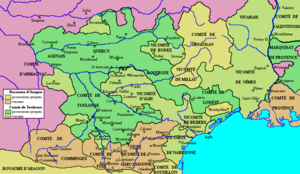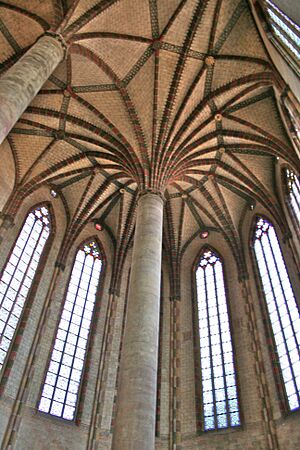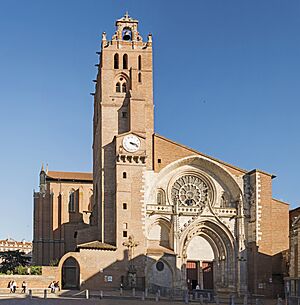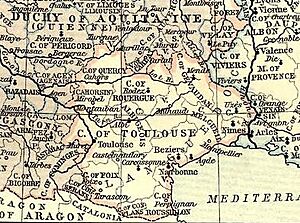County of Toulouse facts for kids
Quick facts for kids
County of Toulouse
|
|||||||||||||
|---|---|---|---|---|---|---|---|---|---|---|---|---|---|
| 778–1271 | |||||||||||||
|
Arms of the counts of Toulouse, 13th century
|
|||||||||||||
|
.
Languedoc at the beginning of the Albigensian Crusade
Dark Green: Lands belonging to the House of Toulouse Green: Vassal lands |
|||||||||||||
| Capital | Toulouse | ||||||||||||
| Common languages |
|
||||||||||||
| Religion |
|
||||||||||||
| Government | Feudal monarchy | ||||||||||||
| Count of Toulouse | |||||||||||||
|
• 778–790
|
Corso | ||||||||||||
|
• 1247–1271
|
Anfós de Peitieus | ||||||||||||
| Historical era | Middle Ages | ||||||||||||
|
• Established by Charlemagne
|
778 | ||||||||||||
|
• Acquired by the French Kingdom
|
1271 | ||||||||||||
| Currency | |||||||||||||
|
|||||||||||||
| Today part of | France | ||||||||||||
The County of Toulouse (Occitan: Comtat de Tolosa) was an important area in southern France during the Middle Ages. It included the city of Toulouse and the lands around it. This region was ruled by a powerful family called the Counts of Toulouse for about 400 years, from the late 800s to the late 1200s.
The county began after Pippin the Short and his son Charlemagne conquered a region called Septimania. Charlemagne set up Frankish rulers, called counts, in important cities like Toulouse. Over time, the counts of Toulouse became very strong. By the end of the 800s, they were almost completely independent from the Frankish kings. Later, in the 12th century, the county faced a big conflict called the Albigensian Crusade. In 1229, the Treaty of Paris officially made Toulouse part of the Kingdom of France, ending its independence.
History of the County of Toulouse
How Toulouse Became a County
The area that became Toulouse was once a Roman province. In the 400s, it was taken over by the Visigothic Kingdom. Later, in the 750s, a part of it, Septimania, was briefly controlled by the Emirate of Córdoba. But in 759, Pippin the Short, a Frankish king, conquered Septimania. This area then became known as Gothia.
When Pippin died in 768, his sons Charlemagne and Carloman I took over. Charlemagne soon became the sole ruler. In 778, he led his army into Spain to fight the Arabs. On his way back, his army was attacked by Basque warriors. This made Charlemagne realize he needed stronger control over the region. So, he reorganized the area and placed Frankish counts in key cities like Toulouse.
In 781, Charlemagne created the Kingdom of Aquitaine. This kingdom included Aquitaine, Gascony, and the Mediterranean coast from Narbonne to Nîmes. These smaller kingdoms helped ensure loyalty in newly conquered areas.
The first count of Toulouse, Chorson, was in charge of the border with Muslim Spain. Toulouse was a major military base for campaigns against the Muslims. For example, Barcelona was conquered in 801. This region became the southern border, or "march," of the Frankish empire.
Toulouse Under Charlemagne's Sons
Charlemagne died in 814. His only surviving son, Louis the Pious, became emperor. Louis had three sons, and he planned to divide his empire among them. This caused problems later on.
In 823, Charles the Bald was born to Louis's second wife. This led to a big family crisis over who would inherit what. When Louis the Pious died in 840, his sons went to war. The empire was eventually split by the Treaty of Verdun in 843. Charles the Bald wanted to control Aquitaine.
In 844, Charles the Bald tried to capture Toulouse, which was the capital of King Pepin II of Aquitaine. But he failed. That same year, Vikings sailed up the Garonne River, attacking cities like Bordeaux. They reached Toulouse but did not attack the strong city. Some historians think Pippin II might have asked the Vikings for help against Charles the Bald.
In 845, Charles the Bald made a deal with Pippin II. Pippin would remain king of Aquitaine but give up some northern lands. However, the people of Aquitaine became unhappy with Pippin II, especially because of the Viking attacks. So, in 848, they asked Charles the Bald to take over.
Counts of Toulouse Gain Power
In 849, Charles the Bald returned. Fredelo, the count of Toulouse, handed the city over to him. Charles the Bald then officially made Fredelo the count. Soon, all of Aquitaine submitted to Charles the Bald.
When Count Fredelo died in 852, Charles the Bald appointed Fredelo's brother, Raymond, as the new count. This was unusual because counts were usually chosen from different families. But this decision started the powerful family line of the counts of Toulouse. They were all descendants of Count Raymond I of Toulouse.
Meanwhile, Pippin II escaped from a monastery and tried to start another rebellion but failed. He even asked the Vikings for help again. In 864, Pippin II and a Viking army besieged Toulouse, but the count of Toulouse defended the city bravely. The siege failed, and Pippin II was captured again.
By the late 800s, the central government in France was losing power. Kings struggled to stop Viking raids. People had to rely on their local counts for protection. These counts became very powerful and started passing their titles down to their sons. This led to local families ruling independently.
In 877, Charles the Bald had to sign the Capitulary of Quierzy. This law allowed counts to pass their titles to their sons. This was a key step in the development of feudalism in Europe. After Charles the Bald died, the Kingdom of Aquitaine ended. The counts in southern France became completely independent. The kings in Paris would not control southern France again for centuries.
Toulouse Becomes Independent
By the end of the 800s, Toulouse was the capital of an independent county. The counts of Toulouse, from Fredelo's family, were technically under the French king but acted completely on their own. They had to fight to keep their power. Other powerful families, like the counts of Auvergne, sometimes challenged them.
In 918, the counts of Toulouse gained control of Gothia, which doubled their territory. The County of Toulouse then stretched from Toulouse in the west to the Rhone River in the east. This area would later be known as the province of Languedoc. Toulouse was no longer part of Aquitaine, which had its capital in other cities.
During this time, the title of King of France became less important. Local rulers had most of the power. In 987, the Capetian dynasty began ruling France. But for Toulouse, the French king's actions didn't matter much until the 1200s.
Challenges in the 10th Century
The 900s were a very difficult time for Western Europe. There were civil wars, bad weather, diseases, and a lot of people died. Central power disappeared, and power was split among many local rulers.
Toulouse and its county also faced these problems. By the late 900s, the counts of Toulouse had lost control over much of their land. Many local rulers controlled only a single town or castle. Even the city of Toulouse was ruled by a viscount who was independent from the counts.
Muslim Spain, under Abd al-Rahman III, launched attacks as far north as Toulouse, but the city was not captured. In 924, the Magyars (ancestors of the Hungarians) also attacked Toulouse but were defeated by Count Raymond III Pons. Despite these challenges, Toulouse was doing a bit better than northern France. Its closeness to Muslim Spain meant new ideas and culture flowed into the city. Toulouse also kept Roman Law, which was different from northern France. This helped the region recover later on.
Growth in the 11th and 12th Centuries
At the start of the 1000s, churches in Toulouse were not well-maintained. New religious movements, like the Cluniac reform, appeared. Bishop Isarn tried to fix things. He gave the Daurade Basilica to the Cluniac abbots in 1077. In Saint-Sernin, he faced opposition from Raimond Gayrard, who wanted to build a new basilica.
With support from Count Guilhem IV, Saint Raymond got permission from Pope Urban II to dedicate the new building in 1096. These religious changes helped awaken faith in Toulouse. The city also grew, with more people and better farming methods.
New areas, called suburbs, were built around the city. The Daurade bridge connected the Saint-Cyprien suburb to the city in 1181. Other suburbs also grew a lot.
At the end of the 1000s, Count Raymond IV left for the crusades. This led to several wars over who would rule Toulouse. In 1119, the people of Toulouse chose Alphonse Jourdain as their count. He showed his thanks by lowering taxes, for example, on salt and wine.
From the mid-1100s, the people of Toulouse started to gain more freedom from harsh feudal rules. After a count died, eight "capitulaires" were chosen to help run the city. These were the Capitouls. Their first actions were recorded in 1152. They were responsible for trade and making sure laws were followed. By 1175, there were twelve Capitouls, six for the city and six for its suburbs. They were elected and swore to uphold justice.
In 1176, the "chapitre" (council) had twelve members, each representing a district. The consuls soon disagreed with Count Raimond V. After ten years of fighting, the city council finally gained control over the count in 1189.
In 1190, construction began on the future Capitole, the city's main government building. The Capitouls, now with twenty-four elected members, took on powers over policing, trade, and taxes. They even started conflicts with nearby cities, usually winning and expanding the influence of Toulouse. The Capitouls gave the city a lot of independence for almost 600 years, until the French Revolution.
The Albigensian Crusade
Catharism was a religious belief that was different from the main Christian church. It became popular in southern France during the 1100s. The Catholic Church saw Cathars as "heretics." Simon de Montfort led a crusade to get rid of them.
Toulouse was also affected by Cathar beliefs. People in the city were divided. The city's leaders, the consuls, did not want to take sides. They refused to identify the heretics. Raymond VI, Count of Toulouse, who was Catholic, was excommunicated by the pope. He later sympathized with the Cathars because he saw how brutal the crusade was.
In 1211, Simon de Montfort tried to besiege Toulouse but failed. Two years later, he defeated the Toulouse army. By 1214, Simon was practically the Count of Toulouse. This was made official by Pope Innocent III in 1215.
Simon de Montfort was killed by a stone during the Siege of Toulouse in 1218. The people of Toulouse fought against Simon's forces. Louis VIII finally gave up in 1219. Raymond VI, grateful for the people's support, gave more power to the Capitouls.
Toulouse Joins the Kingdom of France
The 1200s saw Toulouse move in a new direction. In the Treaty of Paris of 1229, Toulouse officially became part of the French kingdom. The only heir to the county, Joan, was engaged to Alphonse, Count of Poitiers. He was the younger brother of King Louis IX of France. They married in 1241, but they had no children. So, after Joan's death, the county of Toulouse became part of the French crown.
Also in 1229, the University of Toulouse was founded. It was based on the Parisian model and aimed to help stop the Cathar movement. New religious groups, like the "frères prêcheurs," also started. They found a home in Les Jacobins in Toulouse. At the same time, a long period of inquisition began in Toulouse. This meant that people suspected of heresy were investigated and punished. Many important people had to leave or change their beliefs. The inquisition lasted for almost 400 years, with Toulouse as its center.
Count Raimond VII was accused of heresy and died in 1249 without an heir. The county of Toulouse was given to the King of France. The king then ruled through his own appointed officials. The power of the Capitouls was reduced.
In 1323, the Consistori del Gay Saber was created in Toulouse. Its goal was to preserve the lyric art of the troubadours (poets and musicians). Toulouse became a center for Occitan literature for the next hundred years.
Toulouse grew richer as an administrative center. It traded Bordeaux wine with England, as well as grains and textiles. However, the city also faced many challenges. Plagues, fires, and floods damaged the city. The Hundred Years' War also caused a lot of harm. Despite people moving into the city, Toulouse lost 10,000 inhabitants in 70 years. By 1405, only 22,000 people lived there.
Women's Rights in Toulouse
The County of Toulouse, like the wider Aquitaine and Languedoc regions, followed old laws from the Visigothic Kingdom and Roman times. These laws gave women more rights than in many other parts of Europe until the 1900s.
For example, under the Liber Judiciorum (a set of laws from the 600s), women could:
- Inherit land and titles.
- Manage their property on their own, even if they were married.
- Write legal wills if they had no heirs.
- Represent themselves in court and be witnesses by age 14.
- Arrange their own marriages by age 20.
Because of these laws, noble families usually passed down their titles to the oldest male child, but women still had important rights regarding property and legal matters.
Counts of Toulouse
In the early days, under the Carolingians, counts and dukes were chosen by the king. But over time, this job became something that was passed down through families. The Counts of Toulouse ruled the city of Toulouse and the land around it from the late 800s until 1271. Sometimes, members of their family also ruled other areas like Quercy, Rouergue, Albi, Nîmes, Provence, and parts of Septimania.
Sources








